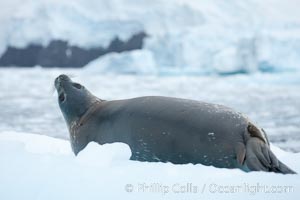
Weddell seal in Antarctica. The Weddell seal reaches sizes of 3m and 600 kg, and feeds on a variety of fish, krill, squid, cephalopods, crustaceans and penguins.
Species: Weddell seal, Leptonychotes weddellii
Location: Cierva Cove, Antarctic Peninsula, Antarctica
Image ID: 25571
Species: Weddell seal, Leptonychotes weddellii
Location: Cierva Cove, Antarctic Peninsula, Antarctica
Image ID: 25571
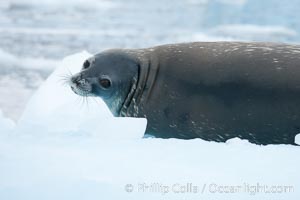
Weddell seal in Antarctica. The Weddell seal reaches sizes of 3m and 600 kg, and feeds on a variety of fish, krill, squid, cephalopods, crustaceans and penguins.
Species: Weddell seal, Leptonychotes weddellii
Location: Cierva Cove, Antarctic Peninsula, Antarctica
Image ID: 25572
Species: Weddell seal, Leptonychotes weddellii
Location: Cierva Cove, Antarctic Peninsula, Antarctica
Image ID: 25572
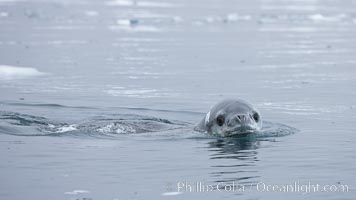
A leopard seal in Antarctica. The leopard seal is a large predatory seal, up to 1300 lb and 11 ft in length, feeding on krill, squid, fish, various penguin species and other seabirds and occasionally, other pinnipeds.
Species: Leopard seal, Hydrurga leptonyx
Location: Cierva Cove, Antarctic Peninsula, Antarctica
Image ID: 25573
Species: Leopard seal, Hydrurga leptonyx
Location: Cierva Cove, Antarctic Peninsula, Antarctica
Image ID: 25573
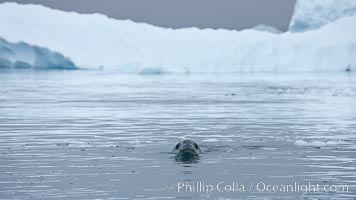
A leopard seal in Antarctica. The leopard seal is a large predatory seal, up to 1300 lb and 11 ft in length, feeding on krill, squid, fish, various penguin species and other seabirds and occasionally, other pinnipeds.
Species: Leopard seal, Hydrurga leptonyx
Location: Cierva Cove, Antarctic Peninsula, Antarctica
Image ID: 25574
Species: Leopard seal, Hydrurga leptonyx
Location: Cierva Cove, Antarctic Peninsula, Antarctica
Image ID: 25574
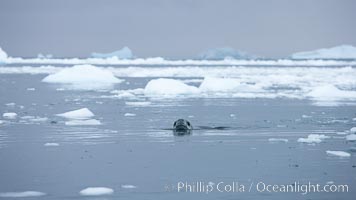
A leopard seal in Antarctica. The leopard seal is a large predatory seal, up to 1300 lb and 11 ft in length, feeding on krill, squid, fish, various penguin species and other seabirds and occasionally, other pinnipeds.
Species: Leopard seal, Hydrurga leptonyx
Location: Cierva Cove, Antarctic Peninsula, Antarctica
Image ID: 25575
Species: Leopard seal, Hydrurga leptonyx
Location: Cierva Cove, Antarctic Peninsula, Antarctica
Image ID: 25575
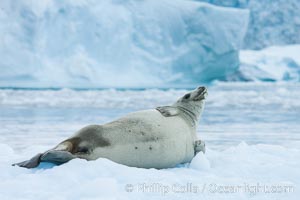
A crabeater seal, hauled out on pack ice to rest. Crabeater seals reach 2m and 200kg in size, with females being slightly larger than males. Crabeaters are the most abundant species of seal in the world, with as many as 75 million individuals. Despite its name, 80% the crabeater seal's diet consists of Antarctic krill. They have specially adapted teeth to strain the small krill from the water.
Species: Crabeater seal, Lobodon carcinophagus
Location: Cierva Cove, Antarctic Peninsula, Antarctica
Image ID: 25577
Species: Crabeater seal, Lobodon carcinophagus
Location: Cierva Cove, Antarctic Peninsula, Antarctica
Image ID: 25577
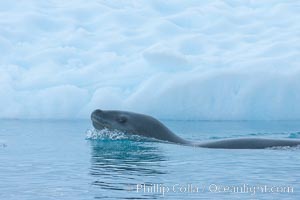
A leopard seal in Antarctica. The leopard seal is a large predatory seal, up to 1300 lb and 11 ft in length, feeding on krill, squid, fish, various penguin species and other seabirds and occasionally, other pinnipeds.
Species: Leopard seal, Hydrurga leptonyx
Location: Cierva Cove, Antarctic Peninsula, Antarctica
Image ID: 25578
Species: Leopard seal, Hydrurga leptonyx
Location: Cierva Cove, Antarctic Peninsula, Antarctica
Image ID: 25578
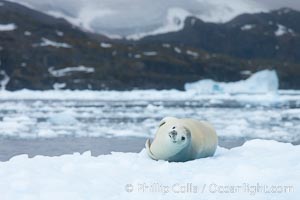
Crabeater seal resting on pack ice. Crabeater seals reach 2m and 200kg in size, with females being slightly larger than males. Crabeaters are the most abundant species of seal in the world, with as many as 75 million individuals. Despite its name, 80% the crabeater seal's diet consists of Antarctic krill. They have specially adapted teeth to strain the small krill from the water.
Species: Crabeater seal, Lobodon carcinophagus
Location: Cierva Cove, Antarctic Peninsula, Antarctica
Image ID: 25579
Species: Crabeater seal, Lobodon carcinophagus
Location: Cierva Cove, Antarctic Peninsula, Antarctica
Image ID: 25579
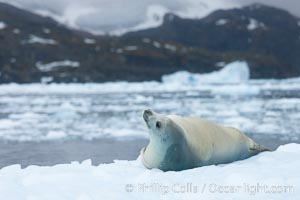
Crabeater seal resting on pack ice. Crabeater seals reach 2m and 200kg in size, with females being slightly larger than males. Crabeaters are the most abundant species of seal in the world, with as many as 75 million individuals. Despite its name, 80% the crabeater seal's diet consists of Antarctic krill. They have specially adapted teeth to strain the small krill from the water.
Species: Crabeater seal, Lobodon carcinophagus
Location: Cierva Cove, Antarctic Peninsula, Antarctica
Image ID: 25580
Species: Crabeater seal, Lobodon carcinophagus
Location: Cierva Cove, Antarctic Peninsula, Antarctica
Image ID: 25580
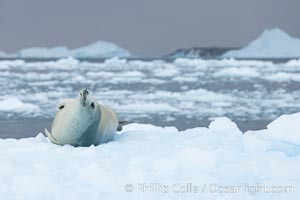
Crabeater seal resting on pack ice. Crabeater seals reach 2m and 200kg in size, with females being slightly larger than males. Crabeaters are the most abundant species of seal in the world, with as many as 75 million individuals. Despite its name, 80% the crabeater seal's diet consists of Antarctic krill. They have specially adapted teeth to strain the small krill from the water.
Species: Crabeater seal, Lobodon carcinophagus
Location: Cierva Cove, Antarctic Peninsula, Antarctica
Image ID: 25581
Species: Crabeater seal, Lobodon carcinophagus
Location: Cierva Cove, Antarctic Peninsula, Antarctica
Image ID: 25581
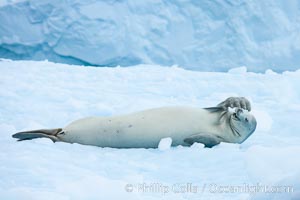
A crabeater seal, hauled out on pack ice to rest. Crabeater seals reach 2m and 200kg in size, with females being slightly larger than males. Crabeaters are the most abundant species of seal in the world, with as many as 75 million individuals. Despite its name, 80% the crabeater seal's diet consists of Antarctic krill. They have specially adapted teeth to strain the small krill from the water.
Species: Crabeater seal, Lobodon carcinophagus
Location: Cierva Cove, Antarctic Peninsula, Antarctica
Image ID: 25582
Species: Crabeater seal, Lobodon carcinophagus
Location: Cierva Cove, Antarctic Peninsula, Antarctica
Image ID: 25582
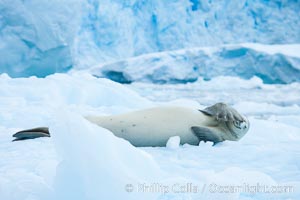
A crabeater seal, hauled out on pack ice to rest. Crabeater seals reach 2m and 200kg in size, with females being slightly larger than males. Crabeaters are the most abundant species of seal in the world, with as many as 75 million individuals. Despite its name, 80% the crabeater seal's diet consists of Antarctic krill. They have specially adapted teeth to strain the small krill from the water.
Species: Crabeater seal, Lobodon carcinophagus
Location: Cierva Cove, Antarctic Peninsula, Antarctica
Image ID: 25583
Species: Crabeater seal, Lobodon carcinophagus
Location: Cierva Cove, Antarctic Peninsula, Antarctica
Image ID: 25583
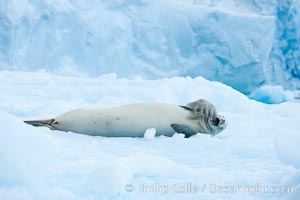
A crabeater seal, hauled out on pack ice to rest. Crabeater seals reach 2m and 200kg in size, with females being slightly larger than males. Crabeaters are the most abundant species of seal in the world, with as many as 75 million individuals. Despite its name, 80% the crabeater seal's diet consists of Antarctic krill. They have specially adapted teeth to strain the small krill from the water.
Species: Crabeater seal, Lobodon carcinophagus
Location: Cierva Cove, Antarctic Peninsula, Antarctica
Image ID: 25584
Species: Crabeater seal, Lobodon carcinophagus
Location: Cierva Cove, Antarctic Peninsula, Antarctica
Image ID: 25584
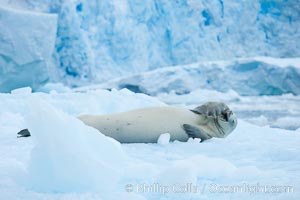
A crabeater seal, hauled out on pack ice to rest. Crabeater seals reach 2m and 200kg in size, with females being slightly larger than males. Crabeaters are the most abundant species of seal in the world, with as many as 75 million individuals. Despite its name, 80% the crabeater seal's diet consists of Antarctic krill. They have specially adapted teeth to strain the small krill from the water.
Species: Crabeater seal, Lobodon carcinophagus
Location: Cierva Cove, Antarctic Peninsula, Antarctica
Image ID: 25585
Species: Crabeater seal, Lobodon carcinophagus
Location: Cierva Cove, Antarctic Peninsula, Antarctica
Image ID: 25585
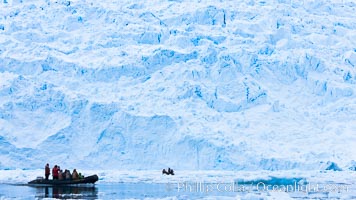
Zodiac cruising in Antarctica. Tourists enjoy the pack ice and towering glaciers of Cierva Cove on the Antarctic Peninsula.
Location: Cierva Cove, Antarctic Peninsula, Antarctica
Image ID: 25590
Location: Cierva Cove, Antarctic Peninsula, Antarctica
Image ID: 25590
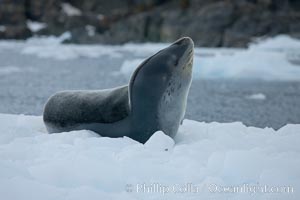
A leopard seal in Antarctica. The leopard seal is a large predatory seal, up to 1300 lb and 11 ft in length, feeding on krill, squid, fish, various penguin species and other seabirds and occasionally, other pinnipeds.
Species: Leopard seal, Hydrurga leptonyx
Location: Cierva Cove, Antarctic Peninsula, Antarctica
Image ID: 25592
Species: Leopard seal, Hydrurga leptonyx
Location: Cierva Cove, Antarctic Peninsula, Antarctica
Image ID: 25592
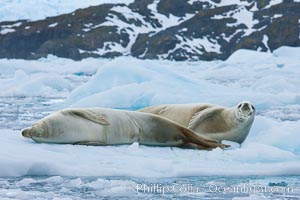
Crabeater seal resting on pack ice. Crabeater seals reach 2m and 200kg in size, with females being slightly larger than males. Crabeaters are the most abundant species of seal in the world, with as many as 75 million individuals. Despite its name, 80% the crabeater seal's diet consists of Antarctic krill. They have specially adapted teeth to strain the small krill from the water.
Species: Crabeater seal, Lobodon carcinophagus
Location: Cierva Cove, Antarctic Peninsula, Antarctica
Image ID: 25597
Species: Crabeater seal, Lobodon carcinophagus
Location: Cierva Cove, Antarctic Peninsula, Antarctica
Image ID: 25597
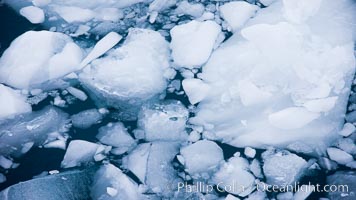
Brash ice floats on cold, dark Antarctic waters.
Location: Cierva Cove, Antarctic Peninsula, Antarctica
Image ID: 25599
Location: Cierva Cove, Antarctic Peninsula, Antarctica
Image ID: 25599
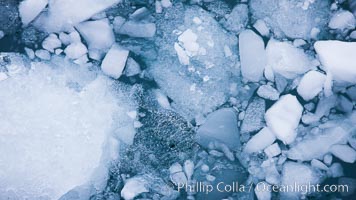
Brash ice floats on cold, dark Antarctic waters.
Location: Cierva Cove, Antarctic Peninsula, Antarctica
Image ID: 25600
Location: Cierva Cove, Antarctic Peninsula, Antarctica
Image ID: 25600
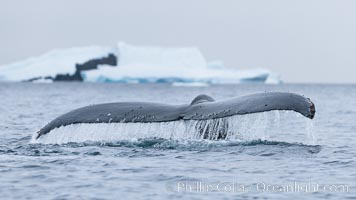
Southern humpback whale in Antarctica, lifting its fluke (tail) before diving in Cierva Cove, Antarctica.
Species: Humpback whale, Megaptera novaeangliae
Location: Cierva Cove, Antarctic Peninsula, Antarctica
Image ID: 25498
Species: Humpback whale, Megaptera novaeangliae
Location: Cierva Cove, Antarctic Peninsula, Antarctica
Image ID: 25498
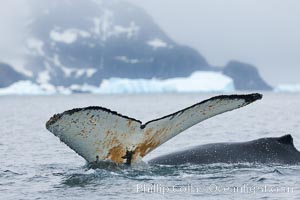
Southern humpback whale in Antarctica, with significant diatomaceous growth (brown) on the underside of its fluke, lifting its fluke before diving in Cierva Cove, Antarctica.
Species: Humpback whale, Megaptera novaeangliae
Location: Cierva Cove, Antarctic Peninsula, Antarctica
Image ID: 25499
Species: Humpback whale, Megaptera novaeangliae
Location: Cierva Cove, Antarctic Peninsula, Antarctica
Image ID: 25499
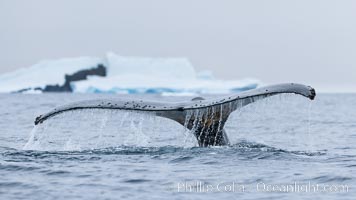
Southern humpback whale in Antarctica, lifting its fluke (tail) before diving in Cierva Cove, Antarctica.
Species: Humpback whale, Megaptera novaeangliae
Location: Cierva Cove, Antarctic Peninsula, Antarctica
Image ID: 25515
Species: Humpback whale, Megaptera novaeangliae
Location: Cierva Cove, Antarctic Peninsula, Antarctica
Image ID: 25515
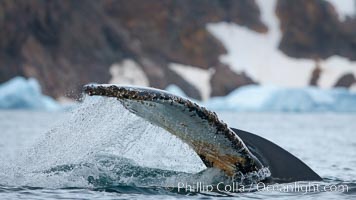
Southern humpback whale in Antarctica, lifting its fluke (tail) before diving in Cierva Cove, Antarctica.
Species: Humpback whale, Megaptera novaeangliae
Location: Cierva Cove, Antarctic Peninsula, Antarctica
Image ID: 25516
Species: Humpback whale, Megaptera novaeangliae
Location: Cierva Cove, Antarctic Peninsula, Antarctica
Image ID: 25516
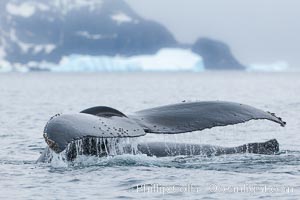
Southern humpback whale in Antarctica, lifting its fluke (tail) before diving in Cierva Cove, Antarctica.
Species: Humpback whale, Megaptera novaeangliae
Location: Cierva Cove, Antarctic Peninsula, Antarctica
Image ID: 25519
Species: Humpback whale, Megaptera novaeangliae
Location: Cierva Cove, Antarctic Peninsula, Antarctica
Image ID: 25519
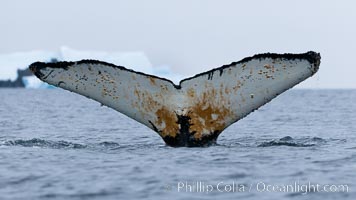
Southern humpback whale in Antarctica, with significant diatomaceous growth (brown) on the underside of its fluke, lifting its fluke before diving in Cierva Cove, Antarctica.
Species: Humpback whale, Megaptera novaeangliae
Location: Cierva Cove, Antarctic Peninsula, Antarctica
Image ID: 25554
Species: Humpback whale, Megaptera novaeangliae
Location: Cierva Cove, Antarctic Peninsula, Antarctica
Image ID: 25554
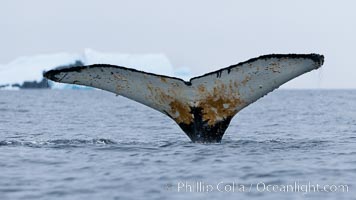
Southern humpback whale in Antarctica, with significant diatomaceous growth (brown) on the underside of its fluke, lifting its fluke before diving in Cierva Cove, Antarctica.
Species: Humpback whale, Megaptera novaeangliae
Location: Cierva Cove, Antarctic Peninsula, Antarctica
Image ID: 25555
Species: Humpback whale, Megaptera novaeangliae
Location: Cierva Cove, Antarctic Peninsula, Antarctica
Image ID: 25555
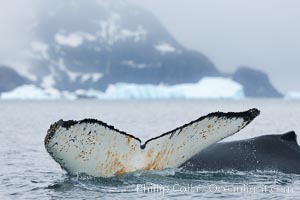
Southern humpback whale in Antarctica, lifting its fluke (tail) before diving in Cierva Cove, Antarctica.
Species: Humpback whale, Megaptera novaeangliae
Location: Cierva Cove, Antarctic Peninsula, Antarctica
Image ID: 25557
Species: Humpback whale, Megaptera novaeangliae
Location: Cierva Cove, Antarctic Peninsula, Antarctica
Image ID: 25557
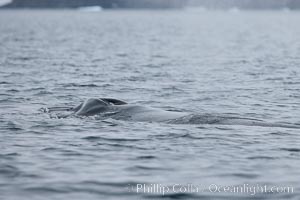
Humpback whale in Antarctica.
Location: Cierva Cove, Antarctic Peninsula, Antarctica
Image ID: 25558
Location: Cierva Cove, Antarctic Peninsula, Antarctica
Image ID: 25558
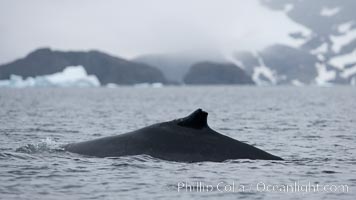
Humpback whale in Antarctica.
Location: Cierva Cove, Antarctic Peninsula, Antarctica
Image ID: 25559
Location: Cierva Cove, Antarctic Peninsula, Antarctica
Image ID: 25559
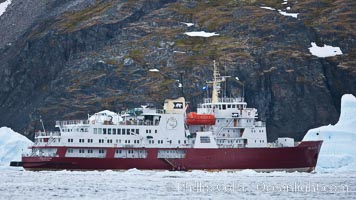
Icebreaker M/V Polar Star, anchored amid pack ice in Cierva Cove.
Location: Cierva Cove, Antarctic Peninsula, Antarctica
Image ID: 25560
Location: Cierva Cove, Antarctic Peninsula, Antarctica
Image ID: 25560